Having owned the Rolex Explorer II 216570 since early October 2011, it's about time that I make a review of it...
The various parts / aspects of the watch will get scores... here's the system:
 = Excellent
= Excellent  = Very Good
= Very Good = Good
= Good = Average
= Average = Bad
= Bad = Terrible
= TerribleThe review will be divided into the following chapters:
- History Of The Rolex Explorer II
- Case
- Bracelet
- Crystal
- Dial And Legibility
- Movement
- Accuracy
- Summary
1. HISTORY OF THE EXPLORER II
In 1971, Rolex released the Explorer II ref. 1655. This tool watch featured a 24hour hand, fixed engraved bezel with 24hour graduation and was only availible with a black dial, and only in steel. The 24hour hand always stayed syncronised to the time the watch was telling... in other words, the Explorer II 1655 was not a "GMT" watch since you could not adjust the 24hour hand independently of the hour hand.
Rather, the 24hour hand - combined with the 24hour graduated bezel - was used to tell the wearer of the watch whether the hour hand is referring to for instance 10 o' clock AM or 10 o'clock PM; particularly useful to speleologists (cave explorers) who spent a lot of their work in dark caves, resulting in the cave explorers losing any notion of whether it was day or night outside the cave.
The dial and hands design of the 38mm diameter and 13.5mm thick Rolex Explorer II 1655 was quite unique; initially at its release featuring a straight seconds hand and a a big orange 24hour hand. Due to the rather big and bold 24hour hand, the Explorer II 1655 was nicknamed "Freccione" (meaning "Arrow") by Italian collectors.
The design of the hour and minute hand was unique, too, with a matte part around the hands stack, making the hands appear to "float" on the dial... no other Rolex watch used or has been using them since in quite this form, although Rolex besides the big orange 24hour hand made a historical nod to those "phantom" hands in 2011 with the release of the Explorer II 216570 (black dial). The Explorer II 1655 also featured small square hour markers corresponding to the uneven numbers on the fixed bezel.
According to an article by Mr M. Siegel, around year 1974 / 1975, the Explorer II 1655 received to updates:
- The straight seconds hand got a luminous dot near the tip (1974)
- The colour of the 24hour hand was changed from orange to red (1975)
Mr M. Siegel also claims that the Explorer II remained in that form ("2" above) until it was discontinued in 1985.
However, more recent studies done by collectors result in the consensus that the "Red 1655 Arrow Hand" actually never existed...
Rather, for a very brief period circa 1978 the 24hr hand was a different deeper shade of orange but was quickly changed back to the standard colour and stayed that way up until the Explorer II 1655 was discontinued.
Most people assume the hand changed colour in 1975 because the 1655 brochure/booklet at that time showed a "redder" hand in the picture. This was a printing problem only.
Over the past 40yrs the orange hands have been very prone to fading - some way more than others depending on exposure to the sun.
Here are the two versions of the Explorer II 1655:
First version (1971 - 1974). Straight seconds hand:
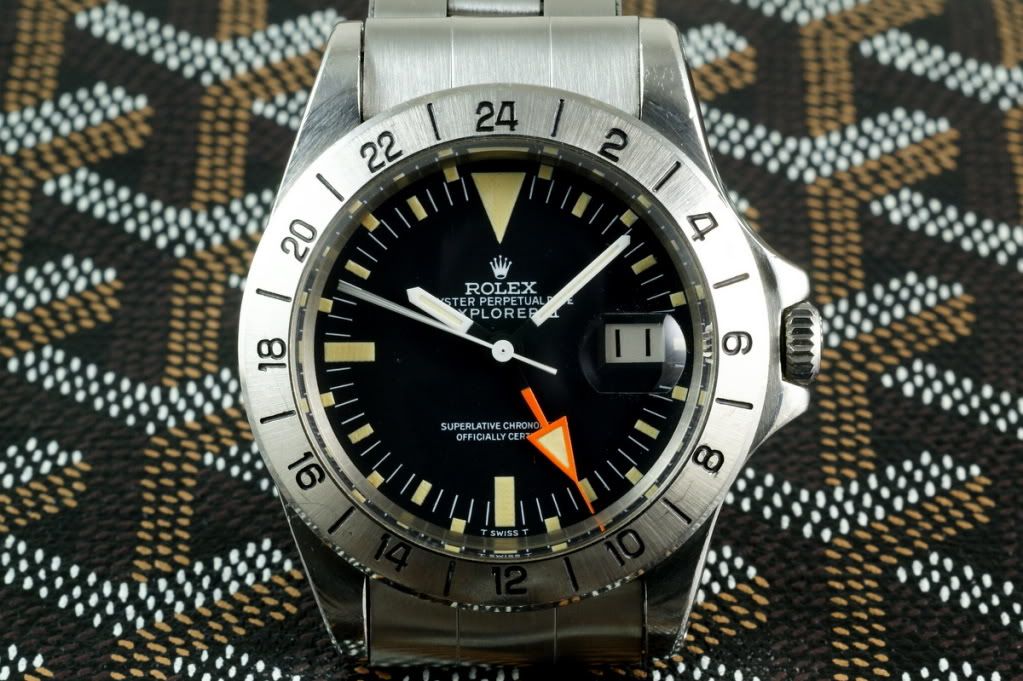
(Source)
Second version (1974 - 1985). Seconds hand with luminous dot:
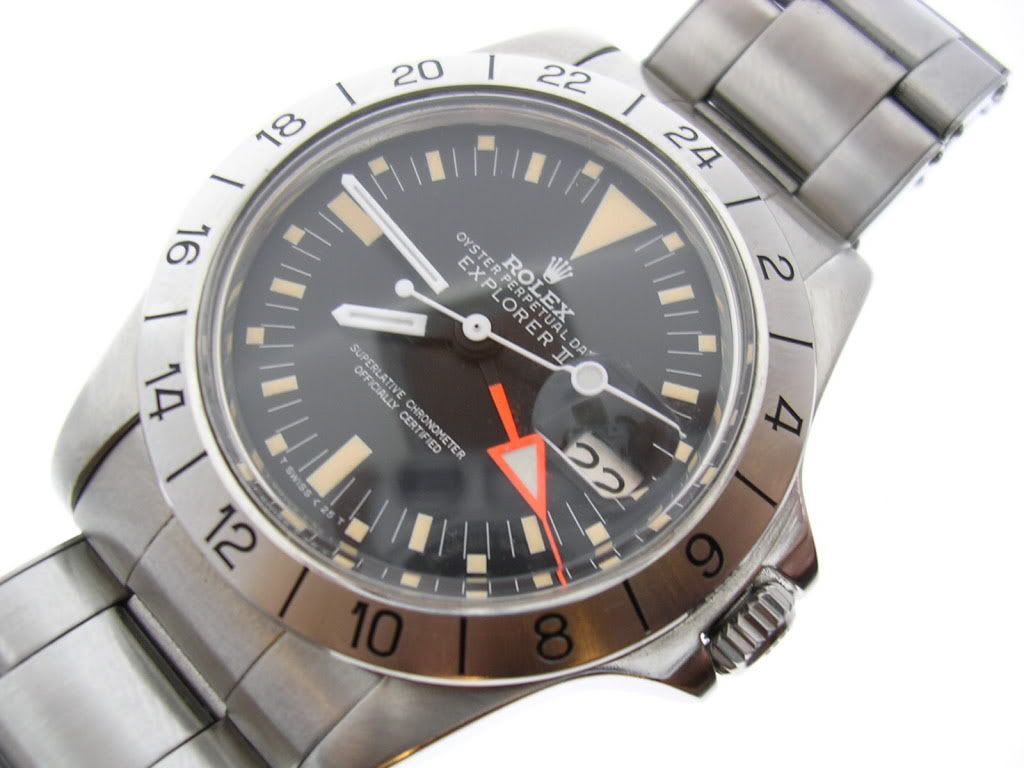
(Source)
In 1985, the Rolex Explorer II 16550 was launched. Although still being 40mm in diameter, this Rolex was radically different from the predecessor model in as much as the 24hour hand was now de-coupled from hour hand, making the wearer of the watch able to move the 24hour hand back and forth in 1hour intervals, independent of the hour hand. In other words, the Explorer II 16550 could now be used as a "GMT" watch (although only able to track two time zones at a time).
Furthermore, the design of the dial and hands was changed, leaving almost no resemblance to the Explorer II 1655.
The Explorer II 16550 now had the Rolex typical skeleton (also known as "Mercedes") hands and a red GMT hand with a smaller, red triangle. There was also an option for either a white or black dial. The satinised bezel featured rather big and bold, fairly deeply engraved numbers.
Originally, the white dial Explorer II 16550 had unpainted dot hour markers... most likely made of white gold because Rolex switched from using steel hands and markers around that time.
Later, the dots indices on the white dial version were painted black. Interestingly, some of the early 16550's had a fault in the paint mixture, making the white dial become cream with time (also known as the "Cream Dial" Explorer II). Furthermore, the dial existed in a "Rail Dial" version (both on black and white dials) where one you draw an imaginary vertical line between the "Superlative" / "Officially" and "Chronometer" / "Certified". The black dial version sometimes developed a "Spider Web" effect due to a fault in the paint mixture:
"Cream and Rail Dial" Explorer II 16550:
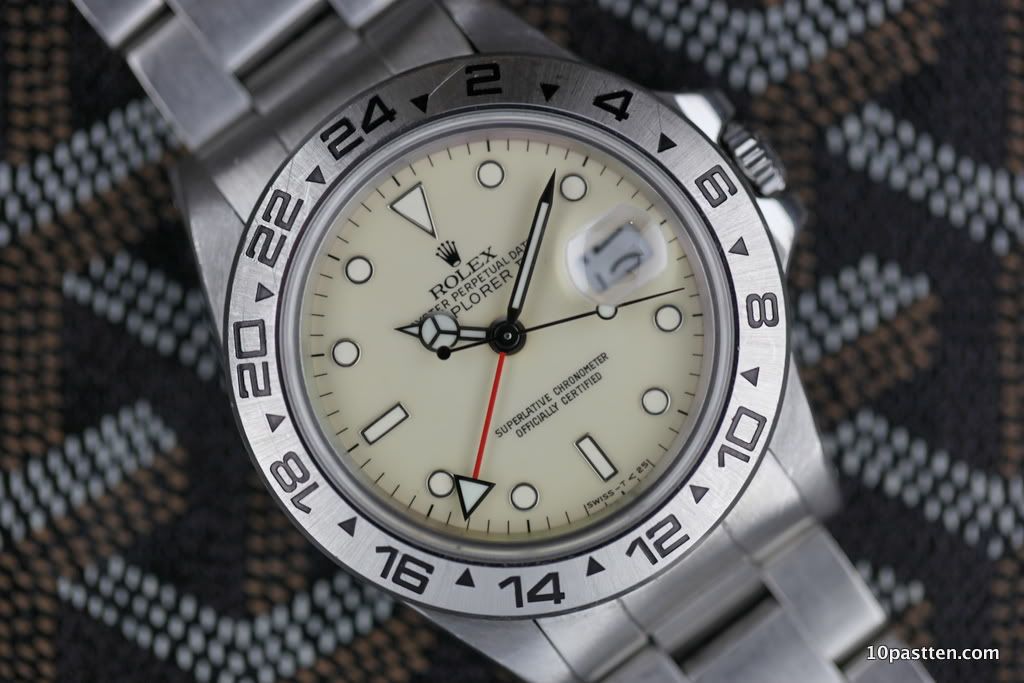
(Source)
"Spider Web" and "Rail Dial" Explorer II 16550:
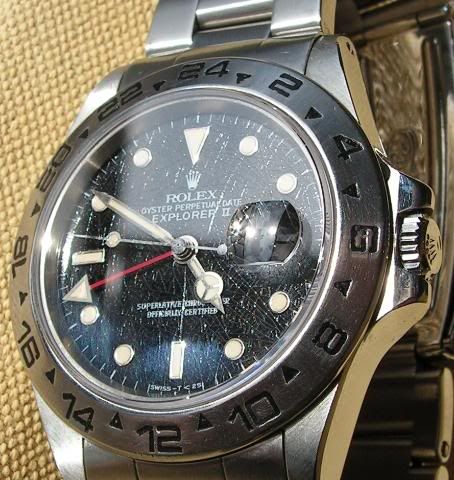
(Source)
The Explorer II 16550 was to be manufacture for only 3 years:
In 1985 it received another update: The movement was changed from Cal. 3085 to Cal. 3185, and the model reference number was hence changed to 16570.
Still availible with either a black or white dial, the white dial now had black hour dots right from the start. Furthermore, the numbers on the fixed bezel were now less bold and deeply engraved:
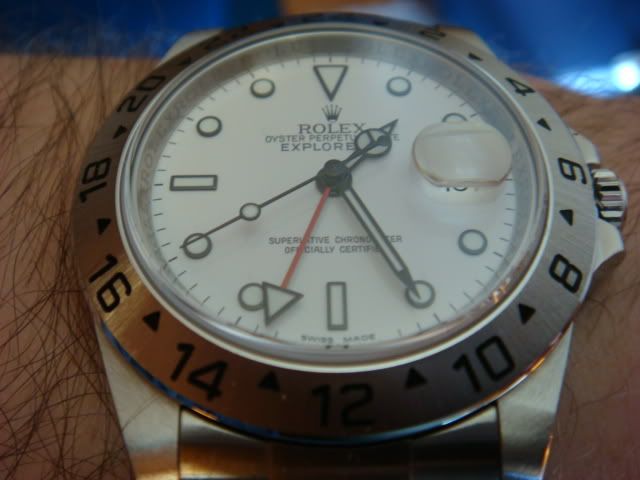
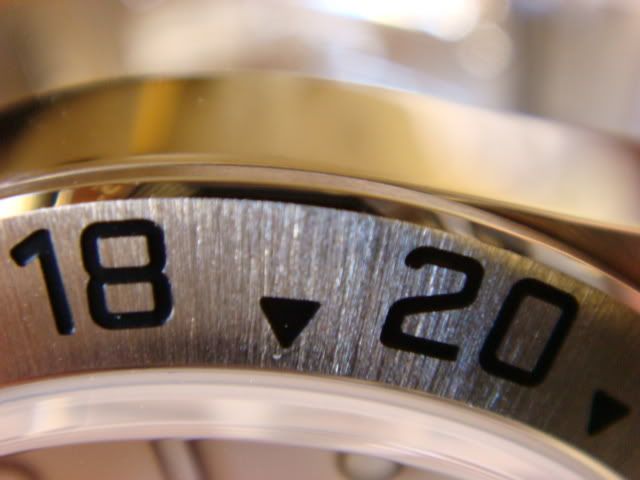
Apart from the M-series and onwards where it received the Cal. 3186 with the inhouse made Parachrom Bleu hairspring, the Explorer II 16570 continued virtually unchanged until 2011 when the Explorer II 216750 was released; one year later than expected / rumoured.
Now let's take a closer look at the Rolex Explorer II 216570:
2. CASE
One of the most striking details of the Explorer II 216570 is its bigger 42mm case. It certainly has "wrist presence" on my 7½" wrist, almost filling my wrist out in width:
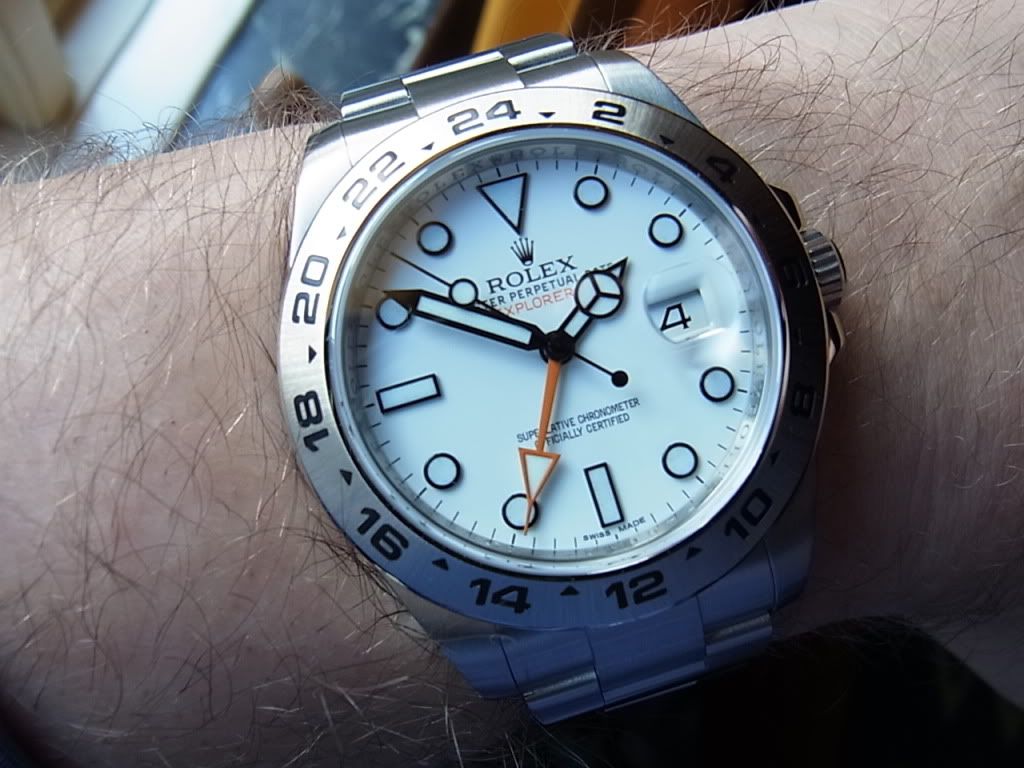
The lug style has been changed compared to the broad "block" lugs of the Rolex GMT II 11671x and Submariner Date 11661x, now more resembling the old-style lugs that had more taper to them. Additionally, like on the new GMT II and Submariner Date, the satination on the lugs is vertical and finer compared to the angled and coarser satination of the 5-digit Rolex sports models:
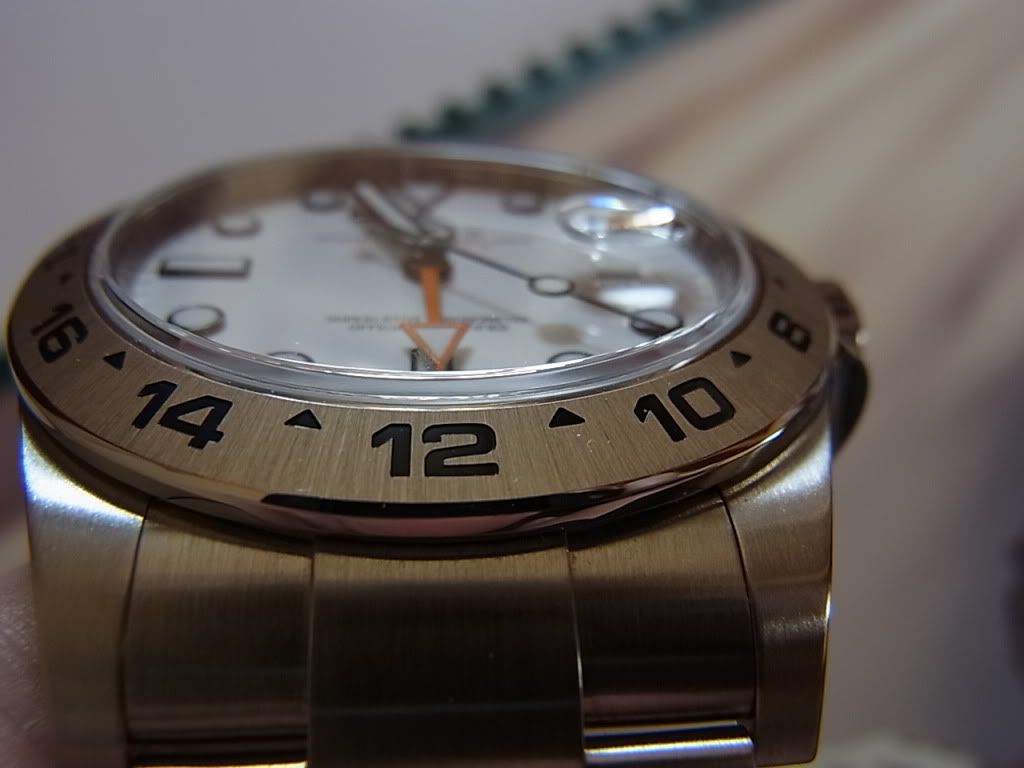
In my opinion, like on the Rolex Deepsea Sea-Dweller, also on the Explorer II 216750 Rolex managed to make the larger case look more proportioned due to those tapering lugs.
Furthermore, there is slightly more curve to the lugs and case when seen from the side as compared to the GMT II 11671x and Submariner Date 11661x:

The bezel design has been changed a bit again. Still being satinised, the numbers on the bezel have become a bit bolder again, making the style resemble the Explorer II 16550 bezel font if one should compare it to earlier models. Like on the earlier models, the edge of the bezel is high-polished, making for a very attractive and elegant contrast to the satinised bezel:

The winding crown has been updated, too, now not more being a standard 6mm Twinlock crown but a larger, 7mm Twinlock, like also seen on the Rolex Milgauss 116400. Compare with the Explorer II 16570:
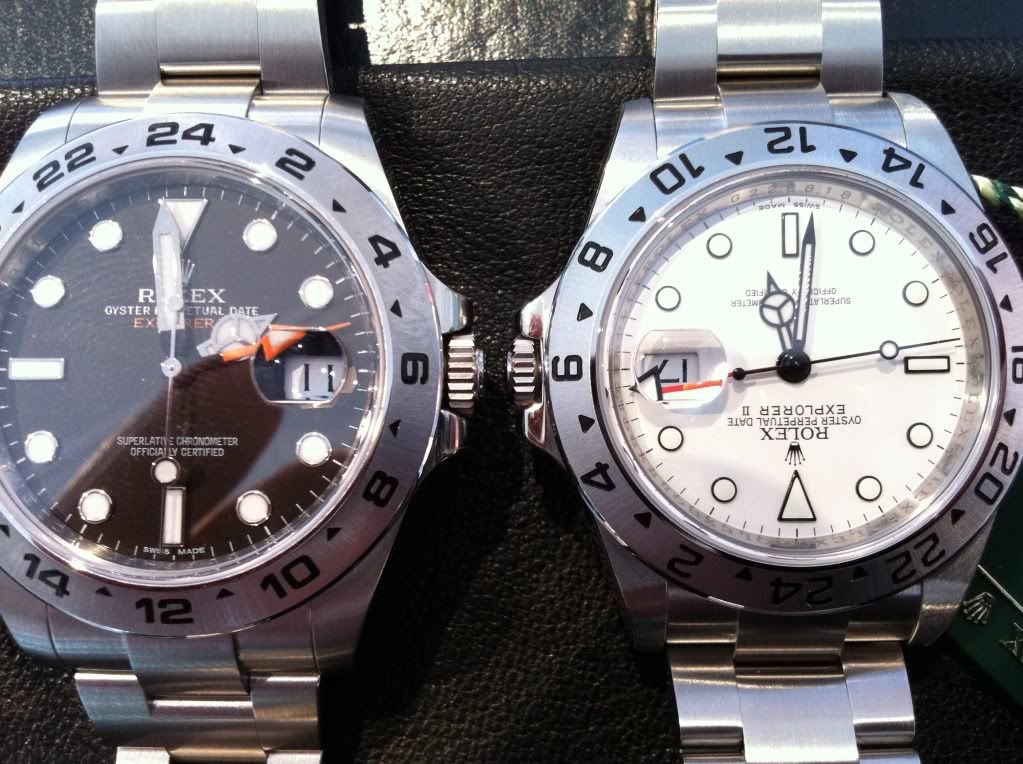
Although I would have preferred a Triplock winding crown on the Explorer II 216570 like on the GMT II 11671x models, in my opinion the larger Twinlock crown still looks good on the watch.
The caseback sits fairly low, in fact making the watch not much thicker than the Explorer II 16570.
Here are the case dimensions, measured with a digital caliper gauge:
- Bezel edge to bezel edge: 41.5mm
- Case diameter incl. crown: 45mm
- Case Length: 48.7mm (lugs at 6 to lugs at 12)
- Case thickness: 12.40mm incl. caseback and crystal
- Lug width: 21mm (tapers down to the last link before clasp which is 15mm)
- Clasp length: 35mm (including the the small protution at the springloaded tip: 36mm)
- Crown diameter: 7mm - same size as Milgauss 116400 crown (standard TwinLock is 6mm)
- Crystal diameter: 33.5mm*)
- Dial diameter: 30mm (from INNER edge of rehaut to the other)
- Width of minute hand: 2mm
- Width of indices: 2mm
- Weight incl. all links: 157g (same weight as Milgauss 116400)
*) Compare: crystal diameter of Rolex Explorer II 16570 which is 30.4mm:
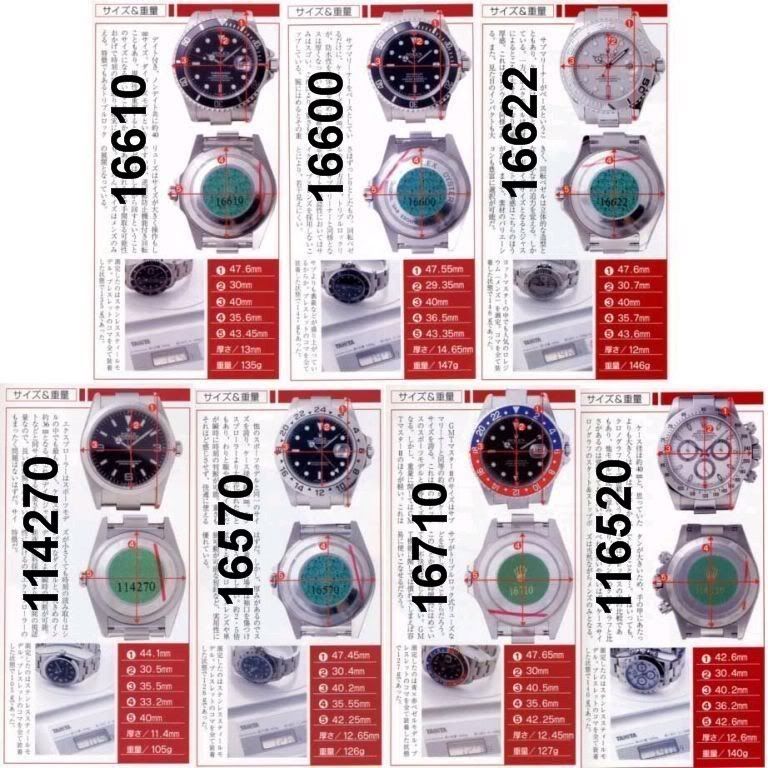
Overall, I find the execution of the Explorer II 216570 case very elegant and stylish. It therefore gets:
SCORE:

3. BRACELET
As expected like with the other updated Rolex watches, the Explorer II 216570 got a new bracelet (Ref. 77210) with solid centre links and solid clasp, featuring the Easy Link that allows for 5mm instant expansion of the bracelet when engaged. The lugwidth is 21mm and suits the 42mm case diameter to perfection. The tapering lugs add to the wellproportioned case/band ratio:

The clasp is machined from one solid piece of 904L steel (same steel type used for the rest of the watch) and sits nicely centered on my wrist:
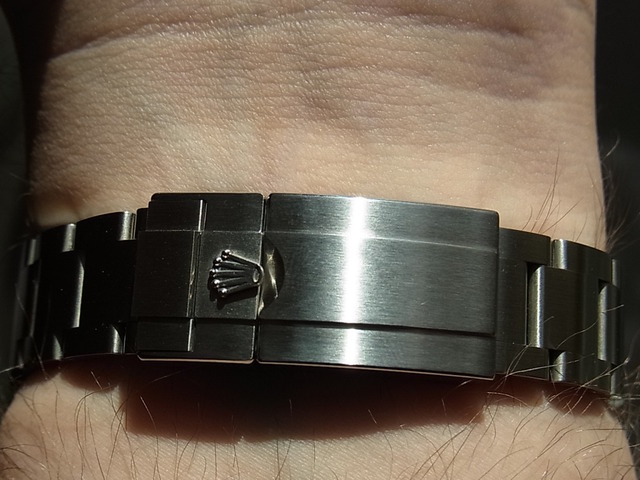
Unlike on the Explorer II 16550 and 16570, the Rolex coronet on the clasp now sits on the Oysterlock:
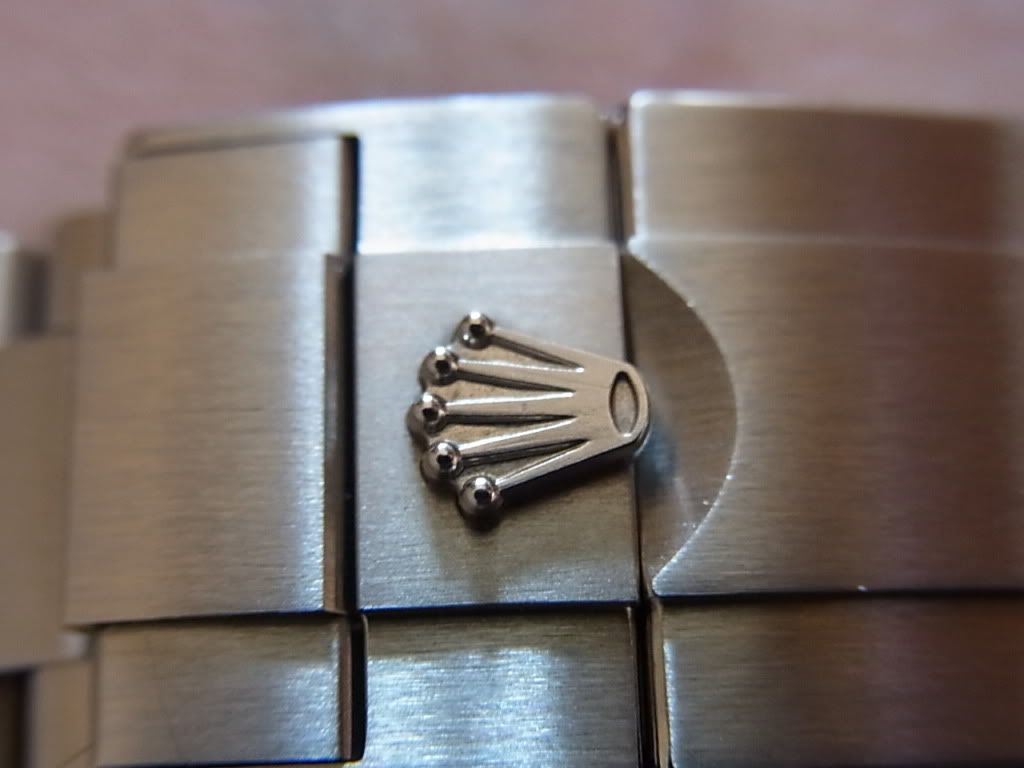
With all links installed and with the Easy Link folded in, the Explorer II 216570 sits extremely comfortably on my wrist. I believe the low-lying caseback adds to this comfort.
From the manufacture, the bracelet ref. 77210 has the following link setup:
- 5 links on the 6 o'clock side (2 with screws) and 7 links on the 12 o'clock side (4 with screws). Easy Link is not included in the count.
Overall, I cannot but give the bracelet the following score:
SCORE:

4. CRYSTAL
I was pleased to see a bigger crystal on the Explorer II 216570!
Like on the on the updated Rolex GMT II 11671x and Submariner Date 11661x, it has an anti-reflective coated cyclops over the date aparture but (apart from its diameter), the crystal is different from the other updated Rolex watches mentioned in as much as the crystal sits higher. I have tried to capture it in this picture:
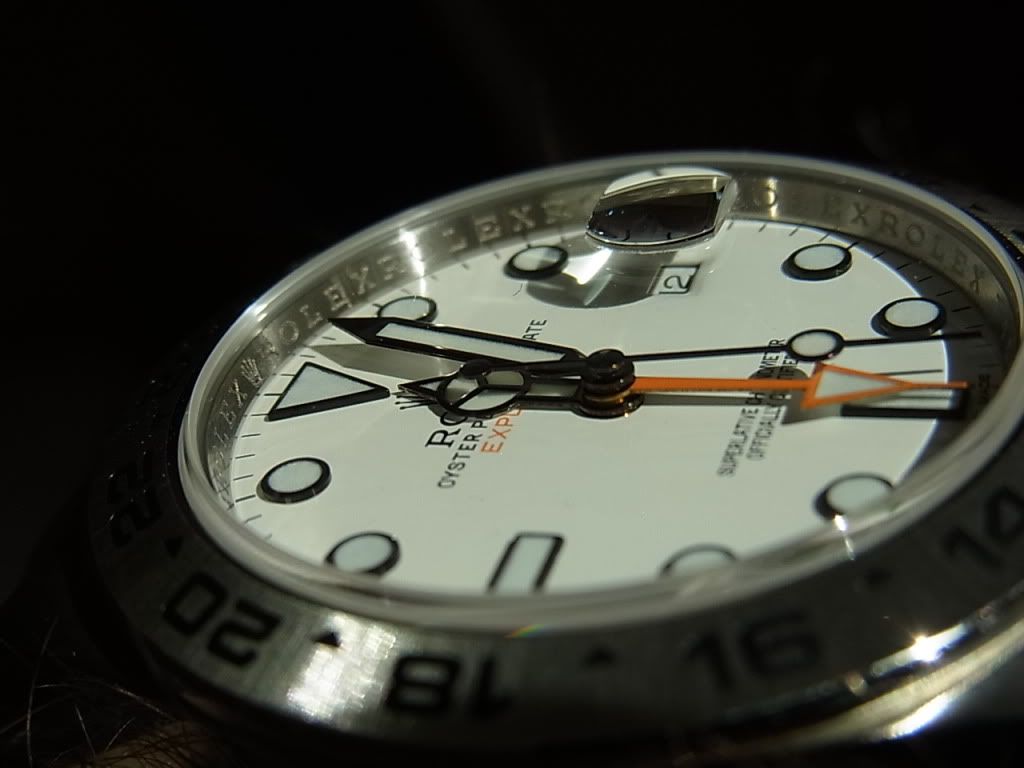
The higher standing crystal makes the new Explorer II slightly thicker than its predecessor model but also makes it look more "old fashioned"... a look which I like.
SCORE:

5. DIAL AND LEGIBILITY
Like the Explorer II 16550 and 16570, the new Explorer II 216570 comes with a choice of either a white or a black dial. I chose the white dial since I find it easier to tell the time from and because I simply prefer the white dial on the Explorer II which also is a nice change to the black dial of my Daytona 116520.
Another reason as to why I opted for the white dial Explorer II 216570 is that (as stated earlier) Rolex made a tribute to the first Explorer II 1655 by adding "Phantom" hands on the new model 216750. However, in my opinion the blackened parts should have been matte instead of glossy which does not match the matte (Rolex calls it "satin finished") black dial of dial. Furthermore, the hands of the black dial new Explorer II have unequal amounts (i.e.: not the same length) of black pain on the hour, minute and GMT hand which spoils the design in my opinion.
Here compared with the Explorer II 16570 where you also get a feel of the size difference:
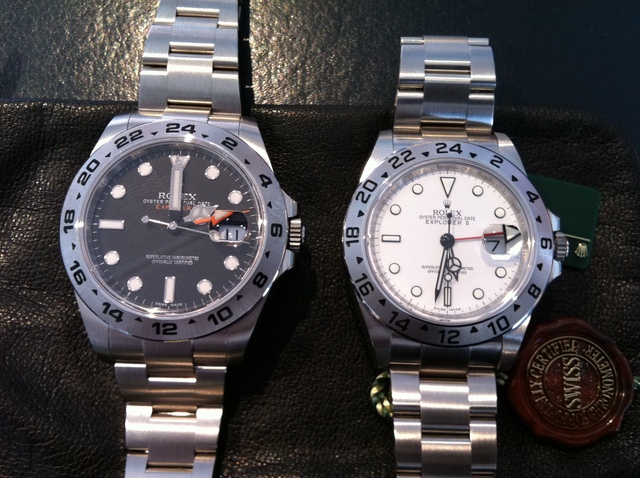
Like the "Phantom" hands on the Explorer II 1655 were re-interpreted, the big orange "Freccione" hand was re-introduced on the new Explorer II as a historical nod. This even seems to be emphasised on the booklet that accompanies the Explorer II 216570:

The big orange 24hour hand looks beautiful together with the orange "Explorer II" writing, although I must admit that I the orange writing on white dial could have been made bolder like seen on the black dial version:
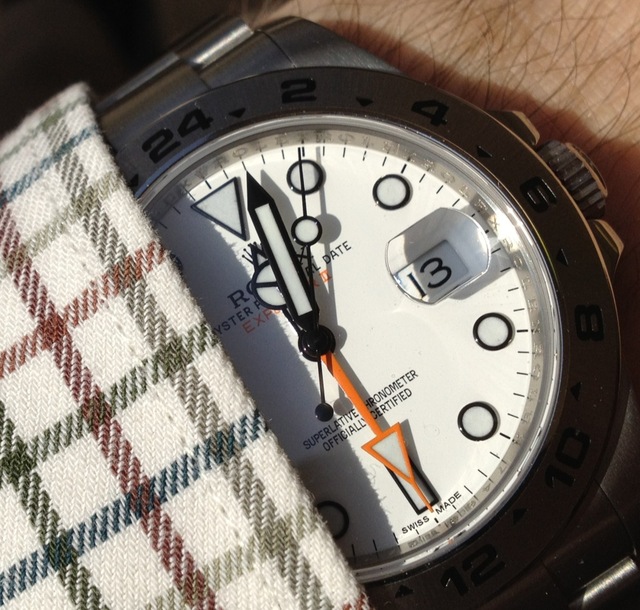
On the predecessor model 16570 (white dial) you could often notice poor quality control of the black painted hands. Notice how the sides of the hands are not painted perfectly:

(Photo by Jocke).
With the new Explorer II, Rolex seems to have paid more attention to this quality control issue:
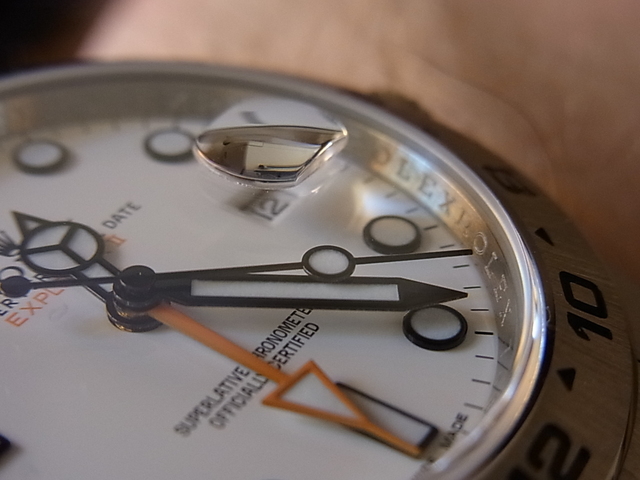
The hands, markers and GMT hand are now "Maxi" style and emit the "Cerachrom" blue lume like on the new Submariner Date, Deepsea Sea-Dweller and Explorer 214270. The lume is fantastic and lasts all night (8+ hours), although not as intense as seen on this photo where I "charged" my Explorer II under the sunlight:
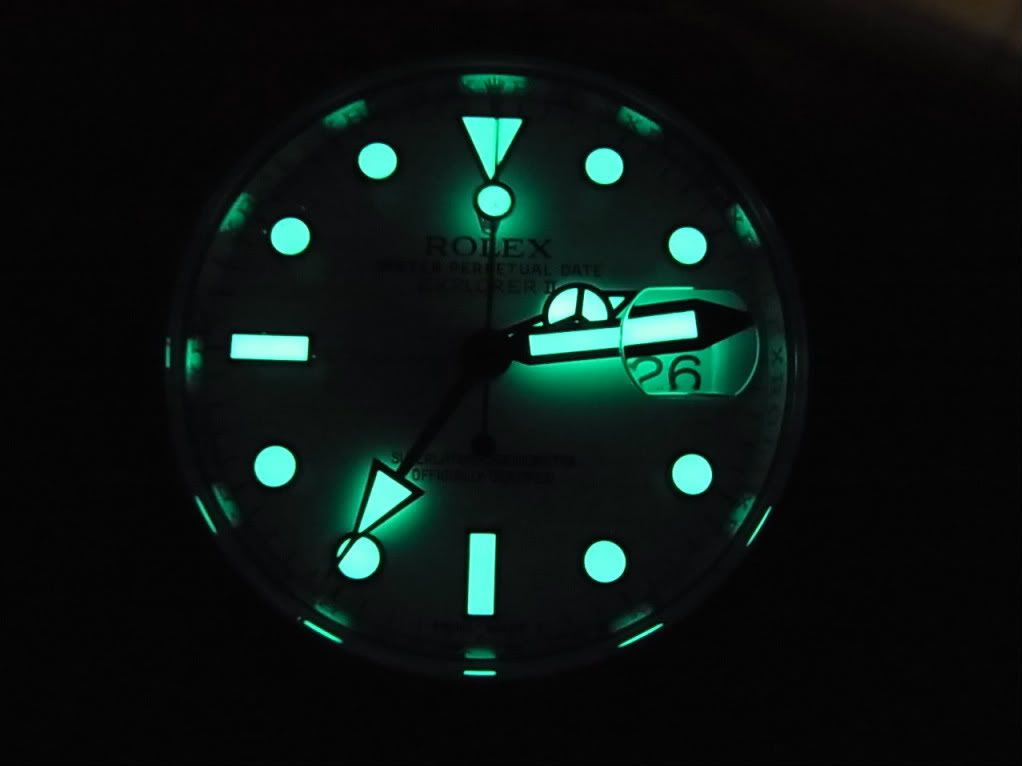
SCORE:

6. MOVEMENT
Rolex manufactured a new movement for the Explorer II 216570:
The Cal. 3187, featuring the inhouse Paraflex shock protection system and Parachrom Bleu hairspring.
The Cal. 3186 in the GMT II 11671x also has the inhouse Parachrom Bleu hairspring...
Now, the question is: Both featuring a GMT feature, is the Cal. 3187 identical to the Cal. 3186 apart from use of the inhouse shock system instead of using the outsourced (SWATCH Group) KIF system?
Answer is Yes... and NO.
Thing is, that the main plate of the Cal. 3187 is bigger than the one of the Cal. 3186:
- Cal. 3186: 28.5mm
- Cal. 3187: 30.97mm
Where most other watch companies introducing a bigger watch model would simply use movement spacers to make a small movement fit into a big case, Rolex did not compromise:
They made the movement bigger, too! This is what makes Rolex so special!
One could argue that the Deepsea Sea-Dweller is 44mm, yet it still has the Cal. 3135 (with the blue hairspring) inside. So why did the Deepsea not receive a bigger movement? Because - combined with the Ring Lock system and Titanium caseback, the Deepsea also has a thicker case (more "meat") around the movement to cope with the 4,875 metres it's tested to withstand under sea-level.
The Cal. 3187 has got to receive the following score:
SCORE:

7. ACCURACY
I have owned various Rolex watches with the inhouse Parachrom Bleu hairspring:
- Rolex Daytona 116520 (x 2)
- Rolex GMT II 116710LN
- Rolex Milgauss 116400GV
- Rolex Explorer II (M-series with Cal. 3186)
- Rolex Deepsea Sea-Dweller 116660 (x 4)
- Rolex Submariner Date 116610
ALL of the above ran slow (typically minus 2-4 seconds/day) straight from the box.
The Explorer II 216570 that I own now has been gaining .5 seconds since day one! Consistantly! It does not get much better than this, so it has to get this score:
SCORE:

8. SUMMARY
To summarize, the Rolex Explorer II 216570 got the following scores:
- History Of The Rolex Explorer II
- Case: SCORE:

- Bracelet: SCORE:

- Crystal: SCORE:

- Dial And Legibility: SCORE:

- Movement: SCORE:

- Accuracy: SCORE:

- Summary
Evidently, it got a 99.99 positive score. Only slight gripe I have is the (in my opinion) too faint orange "Explorer II" writing on the dial.
In my opinion, the Rolex Explorer II is the best executed model that Rolex has released for a long time! It's an instant classic that I can recommend highly!
This comment has been removed by a blog administrator.
ReplyDeleteSorry, I accidentally removed your comment as there were some spam messages earlier. Glad that you had found the post to be informative towards understanding your Rolex. Cheers.
DeleteThis comment has been removed by a blog administrator.
ReplyDelete